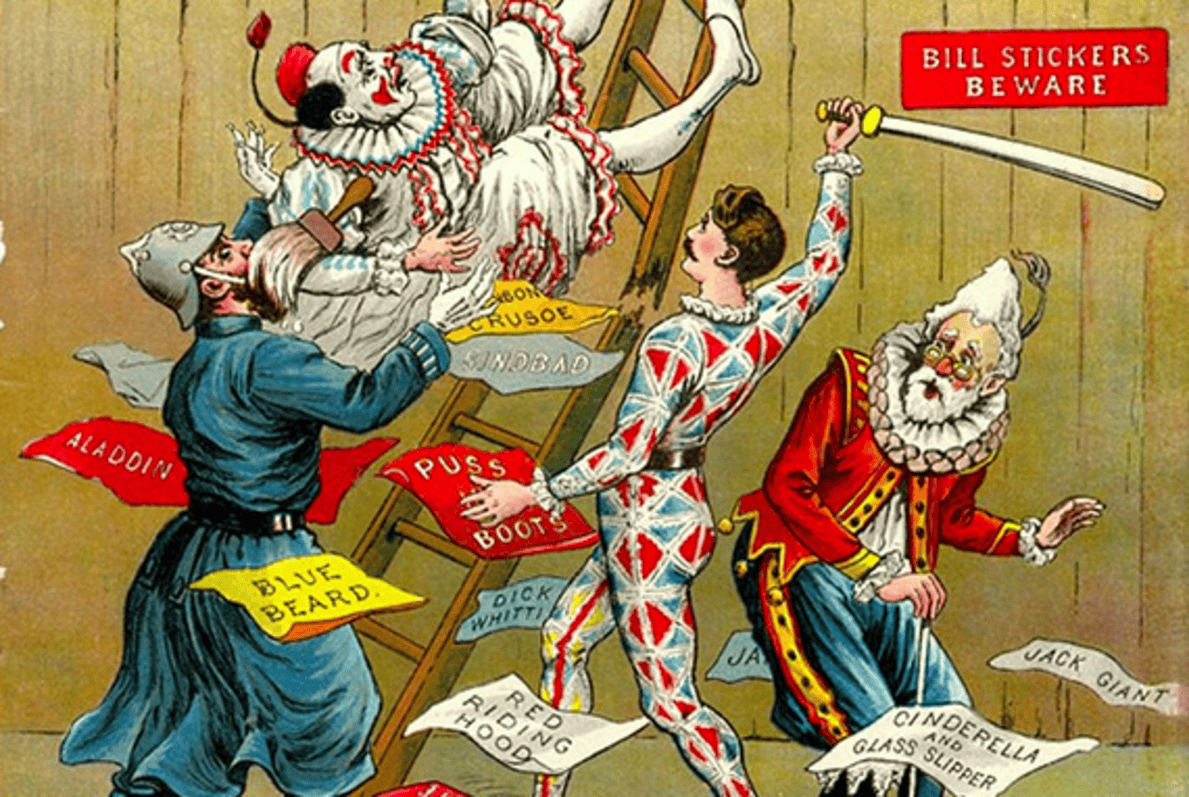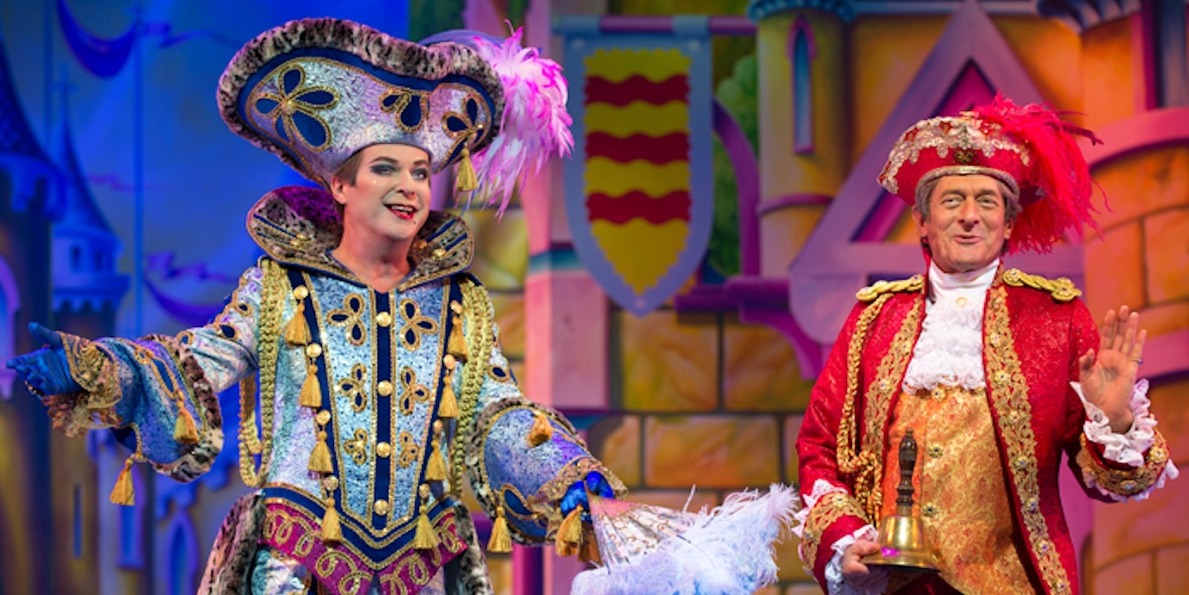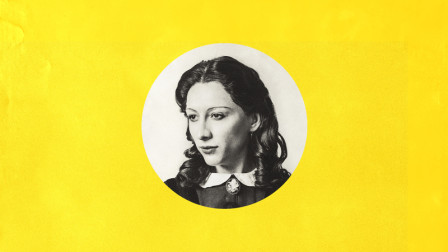Everything You Need To Know About London Palladium's Pantomime
 Shehrazade Zafar-Arif
7 November, 2025, 13:52
Shehrazade Zafar-Arif
7 November, 2025, 13:52
With outlandish costumes, physical comedy, audience participation, and over-the-top characters, pantomime is an iconic part of British theatrical tradition, and the London Palladium is the proud host of some of the most spectacular and star-studded pantomimes in the West End. Here's everything you need to know about the colourful world of panto before Christmas comes around.
 The Christmas Pantomime colour lithograph book cover, 1890,
The Christmas Pantomime colour lithograph book cover, 1890,
The History of Pantomime
Did you know that pantomime originated in 16th century Italy? Comedia dell’Arte was the proginator of panto, with its heavy focus on music, dance, acrobatics, and a cast of mischievous stock characters that audiences would immediately recognise.
In the 18th century, these characters began appearing on London stages in an early form of panto that was based on classical stories, set to music but without speech. Theatre makers and performers such as John Rich and David Garrick began adapting the Commedia dell’Arte so that it evolved into an independent British form, adapting folktales and fairy tales.
In the Victorian era, pantomime became what we’d recognise it as today, featuring witty puns, wordplay, and audience participation, and including fairy-tale characters and magical animals. The broad appeal of the genre was the way it combined nonsense humour with social satire, often commenting on current affairs from the safety of the stage. By the 19th century, it became customary for pantomimes to open on Boxing Day, forever associating this form of theatre with Christmas.
 Charlie Stemp and Lukas Alexander in DICK WHITTINGTON at the London Palladium, 2017.
Charlie Stemp and Lukas Alexander in DICK WHITTINGTON at the London Palladium, 2017.
Pantomime at the London Palladium
The London Palladium has a long and thrilling history of putting on wildly popular pantomimes with a star-studded cast. First built in 1870 as the Corinthian Bazaar, it was renamed Henglera’s Circus twelve years later and began putting on pantomimes, but it was only when it became the London Palladium in 1910 that its tradition of producing world-class pantomimes truly began.
A History of Famous Pantos at the Palladium
1914-1916: Dick Whittington and His Cat becomes the first major pantomime performed at the Palladium in 1914, starring Clarice Mayne and Harry Weldon. It’s followed by Cinderella in 1915 and The House That Jack Built in 1916.
1922: The Palladium returns with Aladdin after being forced to hit pause on their pantos after the First World War.
1953: Fan favourite Cinderella returns, starring the great Julie Andrews alongside Max Bygraves and Richard Heartne.
1969-1986: A string of star-studded pantos follow, including the 1969 Dick Whittington with Tommy Steele, the 1972 Cinderella featuring Terry Scott and Julian Orchard as the Ugly Sisters, and another Cinderella featuring Dame Anna Neagle as Fairy Godmother.
1987: Babes in the Wood is the final panto performed before they begin going out of style, slowly replaced by musicals. Until…
2016: Pantos return to the stage with a bang, starting with Cinderella. Julian Clary, Nigel Havers, and Paul Zerdin become regular and beloved fixtures of the panto scene.
2017-2019: The panto craze is back in full swing, with Dick Whittington in 2016, Snow White in in 2018 (starring Strictly Come Dancing’s Vincent Simone and Flavia Cacace, and the fabulous Dawn French as the evil Queen), and Goldilocks and the Three Bears in 2019.
2020-2021: Pantoland at the Palladium returns after a break due to Covid.
2022-2024: The Palladium’s annual panto tradition is back in action, with Jack and the Beanstalk in 2022, Peter Pan (starring Jennifer Saunders) in 2023, and Robin Hood in 2024.
 Julian Clary and Nigel Havers in CINDERELLA at the London Palladium, 2016.
Julian Clary and Nigel Havers in CINDERELLA at the London Palladium, 2016.
What’s On at the London Palladium This Winter?
This year is the 10th anniversary of the London Palladium’s annual pantomime tradition, and they’re celebrating with a performance of Sleeping Beauty, bringing their usual cheeky, saucy twist on the beloved fairy tale. Full of big-budget extravaganza, innuendos, thrilling special effects, and fabulous costumes, Sleeping Beauty will feature a thrilling cast of comedy, musical, and acting legends. Julian Clary returns as always to play King Julian, with Catherine Tate taking the role of villain as Carrabosse, Paul Zerdin as The Great Zerdini, Nigel Havers as Keeper of the Privy, and Rob Madge as The Diva of Dreams. Joining the cast are Jon Culshaw as King Julian’s private detective and West End stars Emily Lane and Amonik Melaco as Princess Beauty and the Prince.
Why Do Audiences Love Pantos?
Pantos are a funny and clever way to retell familiar, beloved stories, from fairy tales to folktales, making them great fun for children and adults alike. They feature unique and outrageous characters - some, like the Panto Dame, played by a man dressed in drag, are a staple of the genre - that instantly win over audiences. The interactive nature of panto, getting audiences to join in by cheering on heroes and booing villains, makes for a charming shared experience. The rowdy, slapstick humour, cross-dressing shenanigans and gender-blender casting, and sly wit coated in social satire appeal to a quintessentially British sense of humour, but are also delightfully entertaining for non-Brits. Finally, the magical stories filled with music and happy endings make them the perfect cheerful watch for the Christmas season.
 The cast of ROBIN HOOD at the London Palladium, 2024.
The cast of ROBIN HOOD at the London Palladium, 2024.
No festive season is complete without a classic British panto. Book now and usher in the most wonderful time of the year with a sassy, saucy version of Sleeping Beauty like you’ve never experienced it before. Want to fill up your holiday season with even more theatre? Check out our list of Christmas shows for families playing in London this winter.
Latest News

 Full Cast Announced for SHADOWLANDS in the West End
22 December 2025 at 13:14
Full Cast Announced for SHADOWLANDS in the West End
22 December 2025 at 13:14

 Review Round-Up: OH, MARY! at the Trafalgar Theatre
19 December 2025 at 15:53
Review Round-Up: OH, MARY! at the Trafalgar Theatre
19 December 2025 at 15:53

 The Jonathan Larson Project announces London premiere
19 December 2025 at 10:31
The Jonathan Larson Project announces London premiere
19 December 2025 at 10:31

 Oh, Mary at Trafalgar Theatre Review
19 December 2025 at 09:46
Oh, Mary at Trafalgar Theatre Review
19 December 2025 at 09:46